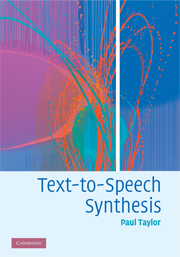Book contents
- Frontmatter
- Contents
- Foreword
- Preface
- 1 Introduction
- 2 Communication and language
- 3 The text-to-speech problem
- 4 Text segmentation and organisation
- 5 Text decoding: finding the words from the text
- 6 Prosody prediction from text
- 7 Phonetics and phonology
- 8 Pronunciation
- 9 Synthesis of prosody
- 10 Signals and filters
- 11 Acoustic models of speech production
- 12 Analysis of speech signals
- 13 Synthesis techniques based on vocal-tract models
- 14 Synthesis by concatenation and signal-processing modification
- 15 Hidden-Markov-model synthesis
- 16 Unit-selection synthesis
- 17 Further issues
- 18 Conclusion
- Appendix A Probability
- Appendix B Phone definitions
- References
- Index
3 - The text-to-speech problem
Published online by Cambridge University Press: 25 January 2011
- Frontmatter
- Contents
- Foreword
- Preface
- 1 Introduction
- 2 Communication and language
- 3 The text-to-speech problem
- 4 Text segmentation and organisation
- 5 Text decoding: finding the words from the text
- 6 Prosody prediction from text
- 7 Phonetics and phonology
- 8 Pronunciation
- 9 Synthesis of prosody
- 10 Signals and filters
- 11 Acoustic models of speech production
- 12 Analysis of speech signals
- 13 Synthesis techniques based on vocal-tract models
- 14 Synthesis by concatenation and signal-processing modification
- 15 Hidden-Markov-model synthesis
- 16 Unit-selection synthesis
- 17 Further issues
- 18 Conclusion
- Appendix A Probability
- Appendix B Phone definitions
- References
- Index
Summary
We now turn to an examination of just what is involved in performing text-to-speech (TTS) synthesis. In the previous chapter, we described some of the basic properties of language, the nature of signal, form and meaning, and the four main processes of generation, encoding, decoding and understanding. We will now use this framework to explain how text-to-speech can be performed.
In TTS, the input is writing and the output speech. While it is somewhat unconventional to regard it as such, here we consider writing as a signal, in just the same way as speech. Normal reading then is a process of decoding the signal into the message, and then understanding the message to create meaning. We stress this, because too often no distinction at all is made between signal and form in writing; we hear about “the words on the page”. More often an informal distinction is made in that it is admitted that real writing requires some “tidying up” to find the linguistic form, for instance by “text normalisation”, which removes capital letters, spells out numbers or separates punctuation. Here we take a more structured view in that we see linguistic form as clean, abstract and unambiguous, and written form as a noisy signal that has been encoded from this form.
The process of reading aloud then is one of taking a signal of one type, writing, and converting it into a signal in another type, speech.
- Type
- Chapter
- Information
- Text-to-Speech Synthesis , pp. 26 - 51Publisher: Cambridge University PressPrint publication year: 2009



